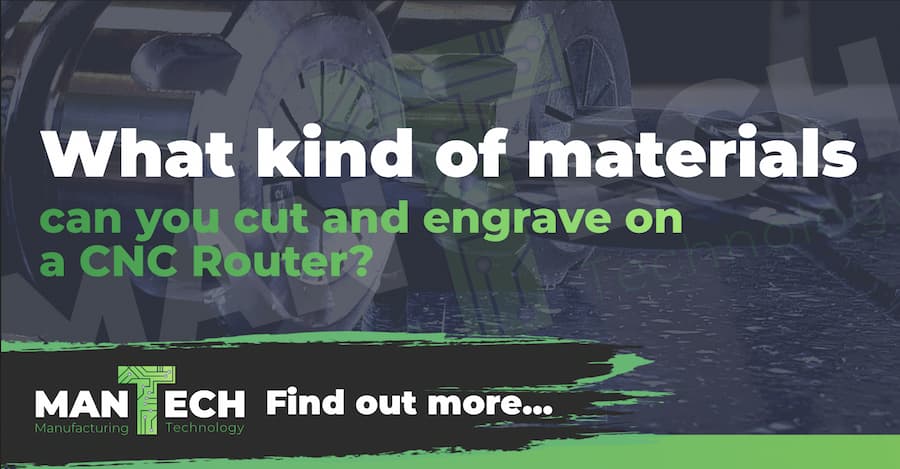A Comprehensive Guide to Materials You Can Cut with a CNC Router (Wood, Metal, Plastics & More!)

Unlocking the versatility of your CNC router starts with understanding the vast range of materials it can handle. From crafting intricate wooden designs to shaping durable metal components and precisely cutting plastics, a CNC router opens up a world of possibilities. This guide will walk you through the most common materials, their applications, and key considerations to help you choose the right material for your next project. We will also give you tips on what CNC router would be best for the material you want to cut.
Working with Wood on Your CNC Router
Wood is one of the most popular materials for CNC routing, offering a blend of workability, affordability, and aesthetic appeal.
Types of Wood: Softwoods vs. Hardwoods
- Softwoods: These come from coniferous trees (like pine, fir, and cedar). They’re generally easier to work with, more affordable, and readily available.
- Typical Applications: Prototyping, signage, some furniture components, decorative panels.
- Advantages: Easy to cut, readily available, cost-effective.
- Disadvantages: Prone to splintering, less durable than hardwoods, requires finishing.
- Tips for Cutting: Use sharp bits, adjust feed rates to prevent tear-out, and consider grain direction.
- Hardwoods: These come from deciduous trees (like oak, maple, cherry, and walnut). They’re denser, stronger, and offer a more refined finish.
- Typical Applications: High-quality furniture, cabinetry, flooring, musical instruments, intricate carvings.
- Advantages: Durable, beautiful grain patterns, takes a fine finish.
- Disadvantages: More expensive, harder to cut (requires more power), can blunt tools more quickly.
- Tips for Cutting: Use high-quality, sharp bits, slower feed rates, and consider climb cutting for a smoother finish.
Plywood and MDF: Pros and Cons
- Plywood: Made from layers of wood veneer glued together, offering greater stability than solid wood.
- Typical Applications: Cabinetry, furniture, shelving, construction.
- Advantages: Stable, strong, less prone to warping than solid wood.
- Disadvantages: Can have voids (gaps) between layers, edges require finishing.
- MDF (Medium-Density Fibreboard): Made from wood fibres and resin, offering a smooth, consistent surface.
- Typical Applications: Signage, decorative panels, speaker boxes, mouldings.
- Advantages: Very smooth surface, takes paint well, affordable.
- Disadvantages: Can be heavy, produces fine dust when cut, not as strong as plywood.
Specialty Woods: Exotic Hardwoods and Reclaimed Lumber
For unique projects, consider exotic hardwoods (like mahogany, ebony, or teak) or reclaimed lumber (for a rustic, sustainable look). These materials often have distinctive grain patterns and colours but can present challenges in terms of sourcing and machining.
Recommended Mantech CNC Machinery for Cutting Wood
Spartan CNC Routers
Falcon ATC CNC Routers
Apollo M CNC Routers
Apollo ATC CNC Routers
Apollo 4 Axis CNC Routers
Dual Bed CNC Routers
Falcon ATC CNC Routers
Apollo M CNC Routers
Apollo ATC CNC Routers
Apollo 4 Axis CNC Routers
Dual Bed CNC Routers
Cutting Metals with Your CNC Router
CNC routers can also handle a variety of metals, opening up possibilities for durable and precise components.
Aluminium: The Versatile Choice
Aluminium is a popular choice due to its lightweight nature, strength, and corrosion resistance.
- Typical Applications: Signage, automotive parts, aerospace components, enclosures, decorative elements.
- Advantages: Lightweight, strong, corrosion-resistant, easy to machine.
- Disadvantages: Can be more expensive than some other metals.
- Tips for Cutting: Use appropriate cutting fluids (lubricants), choose the right bit type (e.g., carbide), secure the material firmly, consider using a single-flute bit.
Brass and Copper: For Decorative and Electrical Applications
These metals offer excellent conductivity and a distinctive aesthetic.
- Typical Applications: Decorative hardware, electrical components, jewellery, plaques.
- Advantages: Excellent conductivity, attractive appearance, corrosion-resistant.
- Disadvantages: Can be expensive, and softer than other metals (prone to bending).
- Tips for Cutting: Use lower speeds and feeds, sharp bits, and consider using a lubricant.
Steel: Strength and Durability Considerations
Steel offers superior strength and durability but requires a more powerful CNC router and careful setup.
- Typical Applications: Heavy-duty components, tooling, structural parts.
- Advantages: Very strong and durable.
- Disadvantages: Requires a powerful router, can be challenging to cut, may require coolants.
- Tips for Cutting: Use a robust machine, and appropriate cutting fluids, choose heavy-duty carbide bits, and use slower speeds and feeds.
Recommended Mantech CNC Machinery for Cutting Metal
As mentioned, cutting steel on a CNC router requires careful setup and a robustly designed machine to achieve safe and accurate cutting. The Apollo ATC range can be used to cut various steel sheet projects using the correct setup and tooling. Please discuss this application with one of our experienced members of the CNC Router sales team for more.
Precision Cutting of Plastics and Acrylics with a CNC Router
Plastics and acrylics are versatile materials that can be easily cut and shaped with a CNC router.
Acrylic (Plexiglass): Clarity and Versatility
Acrylic is known for its optical clarity and ability to be easily formed.
- Typical Applications: Signage, displays, lighting fixtures, protective screens.
- Advantages: Transparent, lightweight, available in various colours, easy to cut.
- Disadvantages: Can be brittle, can crack or chip if not handled carefully.
- Tips for Cutting: Use low speeds, sharp bits designed for plastics, consider using a coolant (air or mist) to prevent melting.
PVC: Durability and Chemical Resistance
PVC is a durable and chemically resistant plastic often used in industrial applications.
- Typical Applications: Piping, ductwork, chemical tanks, signage.
- Advantages: Durable, chemical-resistant, relatively inexpensive.
- Disadvantages: Can produce harmful fumes when heated, not as aesthetically pleasing as some other plastics.
- Tips for Cutting: Use sharp bits, moderate speeds, and ensure good ventilation.
HDPE: A Cost-Effective and Recyclable Option
High-density polyethylene (HDPE) is a strong, durable, and recyclable plastic.
- Typical Applications: Cutting boards, food processing equipment, outdoor furniture.
- Advantages: Durable, chemical-resistant, recyclable, relatively inexpensive.
- Disadvantages: Can be slippery, may require special bits for a clean cut.
- Tips for cutting: Use sharp bits, moderate speeds, ensure the material is secure
ABS: For Prototyping and Functional Parts
Acrylonitrile butadiene styrene (ABS) is a common thermoplastic known for its toughness and impact resistance.
- Typical Applications: Prototyping, automotive parts, enclosures, toys.
- Advantages: Tough, impact-resistant, relatively inexpensive.
- Disadvantages: Can warp if overheated, not as dimensionally stable as some other plastics.
- Tips for Cutting: Use sharp bits, moderate speeds, and consider using a coolant to prevent warping.
Recommended Mantech CNC Machinery for Cutting Plastics and Acrylics
Spartan CNC Routers
Falcon ATC CNC Routers
Apollo M CNC Routers
Apollo ATC CNC Routers
Apollo 4 Axis CNC Routers
Dual Bed CNC Routers
Falcon ATC CNC Routers
Apollo M CNC Routers
Apollo ATC CNC Routers
Apollo 4 Axis CNC Routers
Dual Bed CNC Routers
Other Materials You Can Cut (Foam, Composites, etc.)
Besides the common materials listed above, CNC routers can also handle:
- Foam: Signage, packaging, prototyping (use low-density foams with appropriate bits).
- Composites (Carbon Fibre, Fibreglass): Aerospace, automotive, sporting goods (requires specialised bits and dust extraction).
- Rubber: Gaskets, seals, vibration dampening.
Choosing the Right CNC Router for Your Material
Selecting the right CNC router depends on the materials you plan to cut:
- Router Power: More powerful routers are needed for harder materials like metals and dense hardwoods.
- Spindle Speed: Different materials require different spindle speeds for optimal cutting. Lower speeds are generally used for harder materials, and higher speeds for softer materials.
- Bit Selection: Choosing the right bit material (HSS, carbide, diamond) and geometry (number of flutes, helix angle) is crucial for clean cuts and tool life.
- Dust Collection: Essential for many materials, especially wood, composites, and MDF, to remove debris and maintain air quality.
- Cooling Systems: Important for metals and some plastics to prevent overheating, tool wear, and material damage. Table Size: Ensure your router bed is large enough for the materials you intend to cut.
Conclusion
As you can see, a CNC router offers incredible flexibility in the materials it can handle. By understanding the properties of each material and choosing the right machine and settings, you can achieve precise, professional results. Ready to explore the possibilities?
Contact Mantech Machinery today for expert advice and to find the perfect CNC router for your needs!
CNC Routers




